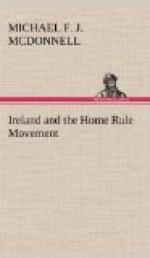The maintenance until thirty-eight years ago of the Established Church, which raised its mitred head in a country where its adherents formed one-eighth of the population, but where its funds were extorted from those who regarded its doctrines as heresy, was, I verily believe, the fons et origo of the sectarian bitterness which still persists among Catholics, “Lui demander,” wrote a French observer of the position of the Catholic Church in the days before 1870, “de s’associer a une telle entreprise lui parait une injure; lui forcer est une violence; la continuance de cette violence est une persecution.” You would find it hard to make me believe that had England been the scene of a similar anomaly, with the roles, of course, exchanged, the feelings towards the Catholic Church, even forty years after its disestablishment, would be the most cordial. The proposals of Pitt for the State payment of the Catholic priesthood were constantly revived and advocated throughout the century. Lord Clarendon’s views, which have just been quoted, were a mere echo of the opinion expressed by Lord John Russell in favour of concurrent endowment in 1844, and there is a significant allusion on the part of Charles Greville fourteen years earlier to the feeling of that time, in which, after speaking about Irish disaffection, he shows the results which were expected from concurrent endowment by commenting unfavourably on the policy which the Government pursued “instead of depriving him (O’Connell) of half his influence by paying the priests and so getting them under the influence of the Government."[19]
The whole question was considered merely in the abstract until the Fenian outburst of the sixties—as Mr. Gladstone freely admitted—opened men’s eyes to this among the other serious problems of Irish government. It required all the violence of desperate men to call, attention to a condition of things in which the Church which was established numbered less than one-eighth of the inhabitants of the country among its adherents.
The part of the country in which the greatest proportion of Episcopalian Protestants was to be found was Ulster, and there they were only 20 per cent. of the people, while in Munster and Connacht they were only 5 and 4 per cent. respectively. In 199 out of 2,428 parishes in Ireland there was not a single member of the Established Church. The net revenue of the Church was L600,000, and of this two archbishops and ten bishops received one-tenth. The mode of solving the inequitable state of affairs which produced least resistance lay in the direction of concurrent endowment. Earl Russell suggested the endowment of Catholics and Presbyterians and the reduction of Episcopalian revenues to one-eighth of their existing amount. To the Presbyterians his plan would have entailed a gain, in so far as the Regium Donum would have been increased, but the opposition to it of the Catholics, in spite of the fact that levelling up rather than planing down appealed not only to Russell but to Grey and Disraeli, resulted in its abandonment, and the question of disestablishment became the recognised solution of the difficulty.




